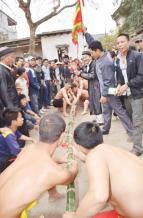EE00001265
 Tugging Rituals and Games
Tugging Rituals and Games
[Inscribed in 2015 (10.COM) on the Representative List of the Intangible Cultural Heritage of Humanity]
Tugging rituals and games of Vietnam have different characteristics, meanings and rules. The element is held as part of village festivals in Spring, a form for communities to pray for abundant harvests and prosperity, marking the start of a new agricultural cycle. Tugging game symbolizes the power of natural forces like the sun, water source that influence the harvests. In some localities, tugging game is associated with the legends of worshiped heroes for their merit in reclaiming the land, fighting against foreign invaders, protecting prosperous life of the people. It is usually held at the communal houses or temples after the rirual of commemoration of local guardian deities finished. The material used for tugging varies from region to region, reflecting the ecological and cultural context of each community, it can be made of bamboo, rattan stems, or ropes. The procedure for selecting teams or players is in accordance to the ritual rules, and the winning or losing team is regulated by customs to express certain religious meanings and the harmony of nature. Nowadays, tugging rituals and games are popularly known as a folk game that is entertaining, sporty and collective.
Vietnam,Cambodia,Philippines,Republic of Korea
2015


